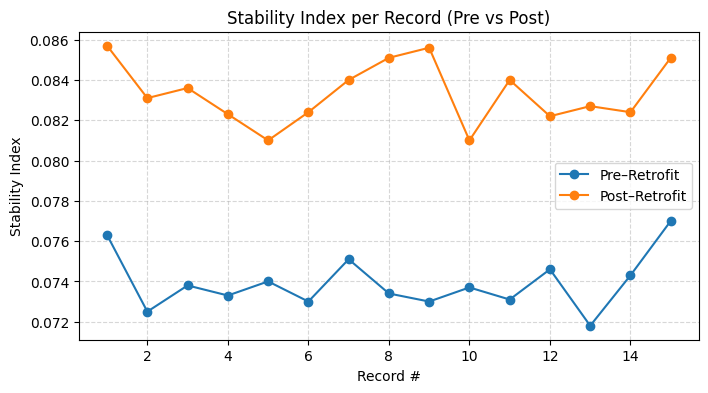Evaluation and Comparison of Structural Stability after Using Dampers and Isolators
Keywords:
Lead-core rubber base isolator, Passive seismic control, Nonlinear time history analysis, Linear viscous damper, Interstory drift, Structural stability, Earthquake engineeringAbstract
This study aims to experimentally assess the simultaneous effectiveness of lead-core rubber base isolators and linear viscous dampers in enhancing the seismic stability of mid-rise steel frame structures. An eight-story steel flexural frame model, scaled 1:4 and designed per the 4th edition of the 2800 Code for Soil Type III, was subjected to dynamic testing using a two-dimensional shake table. The experiment was conducted under fifteen real earthquake accelerograms. First, the model was tested without control devices. Then, four lead-core rubber isolators were installed at the base and two linear viscous dampers on the second and fourth floors. MEMS accelerometers and laser displacement sensors recorded the seismic responses. A paired t-test was used to statistically compare the stability index before and after the control intervention, with significance set at p<0.05. The results demonstrated a statistically significant improvement in structural stability. The average stability index increased by 12.7%, with all 15 records showing consistent positive differences (Δ ranging from 0.0070 to 0.0126). The paired t-test yielded t(14) = 21.769, p < 0.0001, and a Cohen’s d ≈ 5.5, indicating a very large effect size. Time-history analysis revealed a reduction in interstory drift of up to 30% and a substantial decline in floor accelerations, bringing the structure into the code-defined serviceability range. The system displayed consistent performance across a spectrum of seismic inputs, with a coefficient of variation at 18%, indicating high reliability. Economically, the system reduced the demand for secondary reinforcement, offsetting part of its installation cost. The combined use of base isolators and viscous dampers significantly improves seismic performance by reducing drift and accelerations, while ensuring structural stability and economic feasibility. This integrated approach presents a reliable and sustainable solution for enhancing the seismic resilience of mid-rise buildings.
References
P. Naderpoor and T. Taghikhany, "Seismic Adaptive Control of Building Structures With Simultaneous Sensor and Damper Faults Based on Dynamic Neural Network," Computer-Aided Civil and Infrastructure Engineering, vol. 37, no. 11, pp. 1402-1416, 2021, doi: 10.1111/mice.12805.
A. Mahdavi Naderi, F. Khosravi, and R. Rahgozar, "Comparison and simultaneous investigation of the performance of isolation models at the soil-structure interface and dampers at the height of the structure under the effect of seismic load," Physics of Earth and Space, vol. 48IS - 3, pp. 515-529, 2014.
J. Khazaei Nam, M. A. Lotfollahi Yaqin, H. Sotoudeh, and K. Vahabzadeh, "Structural Dynamics Comparative Study of the Performance of Steel Frames with Divergent Braces with and without Dampers," in National Civil Engineering Congress, 2014, p. 8.
V. H. Dezdarani and M. H. P. Mohammadi, "Investigating the Impact of Novel" Damper Systems in Tall Reinforced Concrete Structures to Mitigate Earthquake Forces," 2024, doi: 10.31224/4020.
S. Dumne and M. K. Shrimali, "Seismic Response Analysis of Vertically Irregular RC Building With MR Dampers," Asps Conference Proceedings, vol. 1, no. 1, pp. 843-847, 2022, doi: 10.38208/acp.v1.592.
M. A. Shahraki and S. A. H. Chaleshtori, "Comparative Analysis of Novel Nonlinear Tuned Mass Damper Inerter and Traditional Tuned Mass Dampers in Steel Shear Frame Structures," International Journal of Structural Stability and Dynamics, 2025, doi: 10.1142/s0219455426501415.
X. Kang, J. Tang, J. Wei, X. Jiang, Z. Sheng, and X. Shi, "Parameter Optimization of Vibration Control System for Adjacent Building Structures Based on Negative Stiffness Inerter Damper," Scientific Reports, vol. 14, no. 1, 2024, doi: 10.1038/s41598-024-59380-1.
Y. y. Guo, Z. Tian, X. Wu, L. y. Tan, and H. p. Li, "Research on Seismic Suppression Performance of Vertical Circulation Stereo Garage Based on Friction Damper and Steel Pipe," The Structural Design of Tall and Special Buildings, vol. 33, no. 17, 2024, doi: 10.1002/tal.2177.
Y. Guo, S. Wang, and S. Zhang, "Seismic Performance of Building Structures Based on Improved Viscous Damper Seismic Design," Journal of Vibroengineering, vol. 26, no. 5, pp. 1082-1100, 2024, doi: 10.21595/jve.2024.23988.
Y. E. Hankouri and A. E. Ghoulbzouri, "A Numerical Investigation of the Impact of Non-Linear Viscous Damping on Structural Response to Seismic Excitation," 2024, doi: 10.21203/rs.3.rs-4934385/v1.
C. Jia, H. Su, Y. Li, and Y. Gou, "Linearly Implicit Algorithm With Embedded Newton Iteration of Velocity and Its Application in Nonlinear Dynamic Analysis of Structures," International Journal of Structural Stability and Dynamics, vol. 24, no. 01, 2023, doi: 10.1142/s021945542450010x.
S. Takhirov, A. S. J. Gilani, B. Quigley, L. Myagkova, and S. Kudratov, "Numerical Evaluation of Seismic Retrofitting of Heritage Building by Friction Dampers Based on Geometry Obtained by Laser Scans," pp. 345-353, 2021, doi: 10.1007/978-3-030-90788-4_29.
T. Shiraishi, S. Nagamatsu, and H. Misaki, "High Dynamic Range and High Dispersion Stability of a Magnetorheological Grease Damper for Semi-Active Vibration Suppression," Journal of Intelligent Material Systems and Structures, vol. 33, no. 3, pp. 419-431, 2021, doi: 10.1177/1045389x211018846.
J. Mohammed, S. P. P, L. Gunaraj, and G. Hemalatha, "Study on the Effectiveness of Single-Bolt Double-Lap Joints for Integrating the Damping System With Building Structure During Cyclic Load," World Journal of Engineering, vol. 21, no. 6, pp. 1219-1236, 2023, doi: 10.1108/wje-04-2023-0107.
P. V. Ramana, A. Agnihotri, A. Meena, E. Ganesh, M. K. Shrimali, and S. D. Bharti, "Simulation and Soft Computation on Materials Prognostication Seismic Assessment," Asps Conference Proceedings, vol. 1, no. 1, pp. 1839-1846, 2022, doi: 10.38208/acp.v1.726.
A. Loktev, A. Barakat, and J. Qbaily, "Seismic Behavior of the Main Girder of a Bridge With Viscoelastic Dampers," Vestnik Mgsu, no. 7, pp. 809-818, 2021, doi: 10.22227/1997-0935.2021.7.809-818.
H. N. Li, Z. Huang, and X. Fu, "Study on the Performance of a Gear‐driven Rotation‐amplified Rubber Viscoelastic Damper and Its Vibration Control of a Frame Structure," Structural Control and Health Monitoring, vol. 27, no. 11, 2020, doi: 10.1002/stc.2617.
S. Li, Y. T. Chen, Y. H. Chai, and B. Li, "Effects of Brace Stiffness and Nonlinearity of Viscous Dampers on Seismic Performance of Structures," International Journal of Structural Stability and Dynamics, vol. 21, no. 13, 2021, doi: 10.1142/s0219455421501881.
Y. K. Sahu and M. D. Sahu, "Comparative Study: The Effect of Tuned Mass Damper and Fluid Viscous Damper on the Response of Two Different Models of G+15 Storey Building During Earthquake," Csvtu Research Journal on Engineering and Technology, vol. 10, no. 1, pp. 9-9, 2021, doi: 10.30732/csvturj.20211001009.
M. Zhang and H. Pang, "Analysis of Damping Performance of Frame Structure With Viscoelastic Dampers," Engineering Computations, vol. 38, no. 2, pp. 913-928, 2020, doi: 10.1108/ec-02-2020-0116.
A. Ghaffary and R. K. Mohammadi, "Comprehensive Nonlinear Seismic Performance Assessment of MR Damper Controlled Systems Using Virtual Real‐time Hybrid Simulation," The Structural Design of Tall and Special Buildings, vol. 28, no. 8, 2019, doi: 10.1002/tal.1606.

Downloads
Published
Submitted
Revised
Accepted
Issue
Section
License
Copyright (c) 2025 Mahdi Abbasi (Author)

This work is licensed under a Creative Commons Attribution-NonCommercial 4.0 International License.











